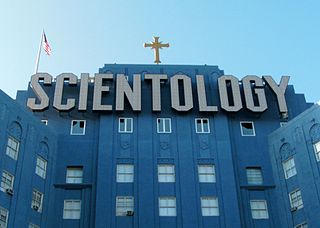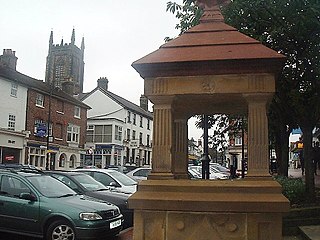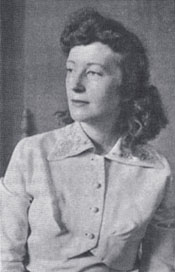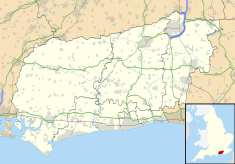
Disconnection is the severance of all ties between a Scientologist and a friend, colleague, or family member deemed to be antagonistic towards Scientology. The practice of disconnection is a form of shunning. Among Scientologists, disconnection is viewed as an important method of removing obstacles to one's spiritual growth. In some circumstances, disconnection has ended marriages and separated children from their parents.

East Grinstead is a town in West Sussex, England, near the East Sussex, Surrey, and Kent borders, 27 miles (43 km) south of London, 21 miles (34 km) northeast of Brighton, and 38 miles (61 km) northeast of the county town of Chichester. Situated in the extreme northeast of the county, the civil parish has an area of 2,443.45 hectares. The population at the 2011 Census was 26,383.

The Church of Scientology maintains a wide variety of beliefs and practices. The core belief holds that a human is an immortal, spiritual being (thetan) that is resident in a physical body. The thetan has had innumerable past lives, some of which, preceding the thetan's arrival on Earth, were lived in extraterrestrial cultures. Based on case studies at advanced levels, it is predicted that any Scientologist undergoing auditing will eventually come across and recount a common series of past-life events.

The Sea Organization, commonly known as the Sea Org, is a core managerial, fraternal, and paramilitary organization of the Church of Scientology. Members hold exclusive control of all Scientology management organizations, in addition to manning and operating a private naval force at several points throughout its history. The Sea Org is not directly incorporated into the structure of the Church of Scientology, but maintains a number of strict responsibilities for its members, beginning with a symbolic billion-year pledge of service to Scientology upon initiation. David Miscavige, the de facto leader of Scientology, is the highest-ranking Sea Org officer with the rank of captain, however the theoretically highest rank of commodore is instead held by the deceased L. Ron Hubbard, the founder of both Scientology and the Sea Organization. Some ex-members and scholars have described the Sea Org as a totalitarian organization marked by intensive surveillance and a lack of freedom.

Mary Sue Hubbard was the third wife of L. Ron Hubbard, from 1952 until his death in 1986. She was a leading figure in Scientology for much of her life. The Hubbards had four children: Diana, Quentin (1954–1976), Suzette, and Arthur.

The Anderson Report is the colloquial name of the report of the Board of Inquiry into Scientology, an official inquiry into the Church of Scientology conducted for the State of Victoria, Australia. It was written by Kevin Victor Anderson QC and published in 1965. The report led to legislation attempting to ban Scientology in Victoria and similar legislation in several other States of Australia. No convictions were made under the legislation and Scientologists continued to practice their beliefs, although the headquarters was moved to South Australia. The legislation has been repealed in all States and subsequently Scientology was found to be a religion by the High Court of Australia.
The Dumbleton–Powles Report is a report on Scientology prepared for the government of New Zealand by E.V. Dumbleton and Sir Guy Richardson Powles, and published on 30 June 1969.

The Church of Scientology is a group of interconnected corporate entities and other organizations devoted to the practice, administration and dissemination of Scientology, which is variously defined as a cult, a business, or a new religious movement. The movement has been the subject of a number of controversies, and the Church of Scientology has been described by government inquiries, international parliamentary bodies, scholars, law lords, and numerous superior court judgements as both a dangerous cult and a manipulative profit-making business. In 1979, several executives of the organization were convicted and imprisoned for multiple offenses by a U.S. Federal Court. The Church of Scientology itself was convicted of fraud by a French court in 2009, a decision upheld by the supreme Court of Cassation in 2013. The German government classifies Scientology as an unconstitutional sect. In France, it has been classified as a dangerous cult. In some countries, it has attained legal recognition as a religion.

The Church of Spiritual Technology (CST) is a California 501(c)(3) non-profit corporation, incorporated in 1982, which owns all the copyrights of the estate of L. Ron Hubbard and licenses their use. CST does business as L. Ron Hubbard Library.

An engram, as used in Dianetics and Scientology, is a detailed mental image or memory of a traumatic event from the past that occurred when an individual was partially or fully unconscious. It is considered to be pseudoscientific and is different from the meaning of "engram" in cognitive psychology. According to Dianetics and Scientology, from conception onwards, whenever something painful happens while the "analytic mind" is unconscious, engrams are supposedly being recorded and stored in an area of the mind Scientology calls the "reactive mind".

A Piece of Blue Sky: Scientology, Dianetics and L. Ron Hubbard Exposed is a 1990 book about L. Ron Hubbard and the development of Dianetics and Scientology, authored by British former Scientologist Jon Atack. It was republished in 2013 with the title Let's sell these people A Piece of Blue Sky: Hubbard, Dianetics and Scientology. The title originates from a quote of Hubbard from 1950; an associate of Hubbard's noted him saying that he wanted to sell potential members "a piece of blue sky".

Recruiting and retaining Scientologist celebrities and getting them to endorse Scientology to the public at large has been important to the Church of Scientology since its early days. The organization has had a written program governing celebrity recruitment since at least 1955, when L. Ron Hubbard created "Project Celebrity", offering rewards to Scientologists who recruited targeted celebrities. Early interested parties included former silent-screen star Gloria Swanson and jazz pianist Dave Brubeck. The Scientology organization has a particular interest in international focus on wealthy businesspeople and influencers to help promote its ideals. A Scientology policy letter of 1976 states that "rehabilitation of celebrities who are just beyond or just approaching their prime" enables the "rapid dissemination" of Scientology.

This is a Timeline of Scientology and its forerunner Dianetics, particularly its foundation and development by author L. Ron Hubbard as well as general publications, articles, books and other milestones.
Saint Hill Green is a small village near East Grinstead, West Sussex, England. Its name is first attested in 1568 as Saynt Hill, which may mean "singed or burned hill".
David Bernard Gaiman was a British businessman and head of the UK branch of Church of Scientology. He and his wife Sheila joined Scientology in the early 1960s and Gaiman served as public relations director and was commonly in the media during the British controversies over Scientology in the 1960s and 1970s.

The relationship between Scientology and religious groups is very complex. While Scientology claims that it is fully compatible with all existing major world religions and that it does not conflict with them or their religious practices, there are significant contradictions between Scientology and most religions, especially the major monotheistic religions. Members are not allowed to engage in other similar mental therapies or procedures, religious or otherwise.
Keeping Scientology Working is a document written by Scientology creator L. Ron Hubbard in 1965, and usually referred to within Scientology as a policy. It is frequently described within the Scientology movement as the most important policy in the Church of Scientology. It ostensibly serves as the keystone for every action, and is mandated to be presented as the first document at the beginning of every single course of study in Scientology. The document was reissued in 1970 and again in 1980. It lays out ten points concerning the exact application and preservation of "Standard Tech" in Dianetics and Scientology, and the eradication of "non-standard tech", more commonly referred to in Scientology as "squirreling."

Scientology in the United Kingdom is practised mainly within the Church of Scientology and its related groups which go under names including "Hubbard Academy of Personal Independence" and "Dianetics and Scientology Life Improvement Centre". The national headquarters, and former global headquarters, is Saint Hill Manor at East Grinstead, which for seven years was the home of L. Ron Hubbard, the pulp fiction author who created Scientology. In the 2021 census, there were 1,844 individuals in England and Wales who listed themselves as Scientologists in their census returns, almost half of which lived in the area around East Grinstead in West Sussex, which hosts the British Scientology Headquarters at Saint Hill Manor. This is a decline of just under a quarter since census day, 2011.

Scientology has a complex relationship with concepts of gender roles and discrimination, as while the core beliefs of Scientology hold humans to consist of genderless Thetans, the Church and other Scientology organizations have frequently been noted as upholding discriminatory policies or views based on the original writings of founder L. Ron Hubbard.
From 1953 to 1967, L. Ron Hubbard was the official leader of the Church of Scientology.









